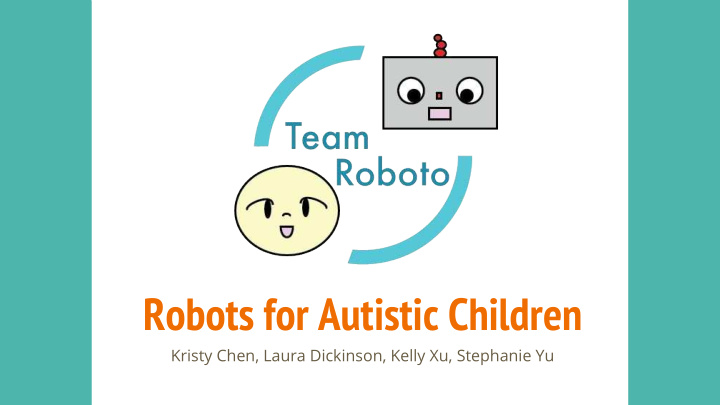



Robots for Autistic Children Kristy Chen, Laura Dickinson, Kelly Xu, Stephanie Yu
Overview ● Autism ● Milo ○ Technology ○ Interactions ● Ethics of Human Contact ● Future Implications
Autism ● Different challenges ○ Communication ○ Social skills ○ Emotions ● Learning is different ● Hard to engage with therapists
Meet Milo Hello!
Technology of Milo ● Motors for exaggerated facial expressions ● Screen with lessons ● Internal HD Cameras ● Voice technology
Interacting With Milo
Ethics: Human Contact ● Dependence on robots can lead to reduced amount on human interaction ● The line between reality and imagination becomes blurred
Future Implications ● Debate: Should they be realistic? ● Personal interaction log ● Not to replace human interaction
Transitional Wearable Companions ● Lights, sounds, vibrations as positive feedback ● Caretaker can override on mobile device ● Keeps a user log ● Wristband with biosensors
robot
References Dautenhahn, K. (2007, April 29). Socially intelligent robots: dimensions of human–robot interaction. Retrieved February 24, 2017, from https://www.ncbi.nlm.nih.gov/pmc/articles/PMC2346526/ Breazeal , C. (n.d.). Sociable machines - Overview. Retrieved February 24, 2017, from http://www.ai.mit.edu/projects/sociable/overview.html Weir, K. (2015). Robo therapy. American Psychological Association,46 (6), 42. Retrieved February 23, 2017, from http://www.apa.org/monitor/2015/06/robo-therapy.aspx PARO Therapeutic Robot. (n.d.). Retrieved February 24, 2017, from http://www.parorobots.com/ What Is Autism? (n.d.). Retrieved February 24, 2017, from https://www.autismspeaks.org/what-autism Social Issues. (2007, April 2). Retrieved February 24, 2017, from https://iancommunity.org/cs/challenging_behavior/social_issues Kaspar the social robot. (2017). Retrieved February 24, 2017, from http://www.herts.ac.uk/kaspar/the-social-robot Abril, D. (January 20, 2016). The Pitch: RoboKind’s humanoid robot generates $500K, interest in first four months. Retrieved from: http://www.bizjournals.com/dallas/blog/techflash/2016/01/the-pitch-robokinds-humanoid-robot-generates-500k.html Acapela Group. (December 15, 2015). Advanced Robots: Meet Milo, an Intelligent Robot That is Really Good at Teaching Children with Autism Social Skills. Retrieved from: http://www.prnewswire.com/news-releases/advanced-robotics-meet-milo-an-intelligent-robot-that-is-really-good-at-teaching-children-with-autism-social-skills-562351711.html Anderson, R. (February 23, 2016). Meet Milo, a Social Robot Like No Other. Retrieved from: https://abilitytools.org/blog/meet-milo-a-social-robot-like-no-other/ Cabibihan, J., Javed, H., Ang, M., & Aljunied, S. M. (2013). Why robots? A survey on the roles and benefits of social robots in the therapy of children with autism. International Journal of Social Robotics, 5(4), 593-618. doi:10.1007/s12369-013-0202-2 Corbly, L. (April 18, 2015). Robot Milo helps children with autism learn social skills. Retrieved from: http://www.deseretnews.com/article/865626671/Robot-Milo-helps-children-with-autism-learn-social-skills.html Dautenhahn, K. (2003). Chapter 8: Playing and learning with robots. In Future of learning: Issues and prospects (pp. 163-184). Amsterdam, NL: IOS Press. Retrieved February 23, 2017, from: http://www.ebrary.com Dautenhahn, K. (2003). Roles and functions of robots in human society: Implications from research in autism therapy. Robotica, 21(4), 443-452. doi:10.1017/s0263574703004922 iESD. (July 6, 2016). iESD Case Study: Children on the Autism Spectrum Show Improvement with Robots4Autism in Spartanburg, South Carolina. Retrieved from: http://www.autism-society.org/wp-content/uploads/2016/10/Robokind-Efficacy.pdf Firth, S. (March 9, 2015). Autism Therapy From a Robot? Retrieved from: http://www.medpagetoday.com/pediatrics/autism/50386 Giullian, N., Ricks, D., Atherton, A., Colton, M., Goodrich, M., & Brinton, B. (2010). Detailed requirements for robots in autism therapy. IEEE International Conference on Systems, Man and Cybernetics. doi:10.1109/icsmc.2010.5641908 Groopman, J. (2009, November 2). Robots That Care. The New Yorker, 85(35), 66. Retrieved from: http://go.galegroup.com/ps/i.do?p=LitRC&sw=w&u=wash_main&v=2.1&it=r&id=GALE%7CA211029143&asid=592fd377866fea7ac6c4c5cc2d3ebe2a Lee, J., Takehashi, H., Nagai, C., Obinata, G., & Stefanov, D. (2012). Which Robot Features Can Stimulate Better Responses from Children with Autism in Robot-Assisted Therapy? International Journal of Advanced Robotic Systems, 9(3), 72. doi:10.5772/51128 Özcan, B., Caligiore, D., Sperati, V., Moretta, T., & Baldassarre, G. (2016). Transitional Wearable Companions: A Novel Concept of Soft Interactive Social Robots to Improve Social Skills in Children with Autism Spectrum Disorder. International Journal of Social Robotics, 8(4), 471-481. doi:10.1007/s12369-016-0373-8 Ricks, D. J., & Colton, M. B. (2010). Trends and considerations in robot-assisted autism therapy. 2010 IEEE International Conference on Robotics and Automation. doi:10.1109/robot.2010.5509327 RoboKind. (2015). RoboKind is a leader in the robotics industry. Retrieved from: http://www.robokindrobots.com/robots/ Robots4Autism. (2015). Meet Milo. Retrieved from: https://robots4autism.com/milo/ Tucker, E. (February 1, 2015). How robots are helping children with autism. Retrieved from: https://www.theguardian.com/lifeandstyle/2015/feb/01/how-robots-helping-children-with-autism Walsh, K. (June 30, 2016). Meet Milo! A Robot Kid that Excels at Teaching Social Skills to Kids with Autism. Retrieved from: http://www.emergingedtech.com/2016/06/robot-engages-children-with-autism-to-teach-social-skills/ Yee, A. W., Kee, T. Y., Limbu, D. K., Jian, A. T., Dung, T. A., & Yuen, A. W. (2012). Developing a robotic platform to play with pre-school autistic children in a classroom environment. Proceedings of the Workshop at SIGGRAPH Asia, 81-86. doi:10.1145/2425296.2425311
Recommend
More recommend